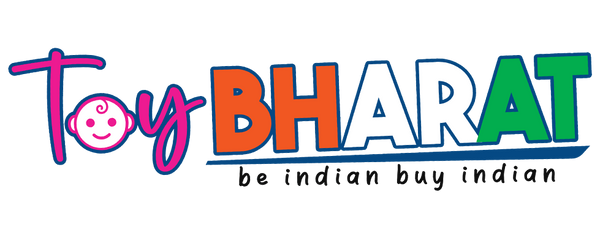In today’s global market, parents are faced with countless choices when it comes to selecting toys for their children. Safety is often the top priority, and with recent concerns about the safety standards of toys manufactured in different countries, it's important to make informed decisions. In this blog, we’ll explore why Indian toys are considered safer compared to Chinese toys, highlighting key safety standards, manufacturing practices, and regulatory frameworks.
Strict Safety Standards in India
- ISI Certification
One of the primary indicators of toy safety in India is the ISI (Indian Standards Institute) certification. This mark ensures that the toy has been tested and meets the rigorous safety standards set by the Bureau of Indian Standards (BIS). Toys bearing the ISI mark have passed stringent quality checks, including tests for mechanical safety, chemical composition, and overall durability. This certification is mandatory for toys sold in India, ensuring that parents can trust the products they purchase.
- Compliance with International Standards
Indian toy manufacturers often comply with international safety standards such as the European Union’s EN 71 and the United States’ ASTM F963. This dual compliance ensures that Indian toys meet or exceed global safety benchmarks, offering additional assurance to parents about the safety of these products.
Transparency in Manufacturing Practices
- Use of Non-Toxic Materials
Indian toy manufacturers are increasingly focusing on using non-toxic, child-safe materials. This includes BPA-free plastics, lead-free paints, and natural dyes. These materials are carefully selected to minimize any potential health risks to children, making Indian toys a safer choice.
- Ethical Manufacturing Processes
Many Indian toy companies adhere to ethical manufacturing practices, ensuring that toys are produced in safe, regulated environments. These practices include fair labor standards, environmentally sustainable production methods, and regular safety audits. This transparency and commitment to ethical manufacturing enhance the overall safety and reliability of Indian toys.
Government Regulations and Oversight
- Stringent Regulatory Framework
The Indian government has implemented a robust regulatory framework to oversee the toy industry. Agencies such as the BIS and the Ministry of Consumer Affairs regularly update safety guidelines and conduct market surveillance to ensure compliance. This proactive approach helps prevent the distribution of unsafe toys and protects consumers.
- Recalls and Safety Alerts
Indian authorities are vigilant about toy safety and are quick to issue recalls and safety alerts if a product is found to be unsafe. This responsiveness ensures that potentially harmful toys are swiftly removed from the market, reducing the risk to children.
Comparative Insights: Chinese Toys
- Concerns Over Quality Control
While China is a major global producer of toys, there have been numerous reports of quality control issues, including the use of hazardous materials such as lead-based paints and unsafe chemicals. These concerns have led to several high-profile recalls and have raised questions about the overall safety of Chinese-made toys.
- Inconsistent Safety Standards
The regulatory environment in China can vary significantly, with some manufacturers not adhering to the same stringent safety standards required in India. This inconsistency can result in toys that do not meet basic safety requirements, posing potential risks to children.
- Mass Production Risks
China’s emphasis on mass production often prioritizes quantity over quality. This approach can lead to compromised safety standards, as manufacturers rush to meet high production targets. The lack of thorough safety testing and quality checks in such scenarios further exacerbates the risk of unsafe toys reaching the market.
Choosing Safety: Tips for Parents
- Look for Certification Marks
Always check for certification marks such as the ISI mark when purchasing toys. This ensures that the toy has been tested and meets the required safety standards.
- Research the Manufacturer
Take the time to research the toy manufacturer’s reputation and adherence to safety standards. Look for brands known for their commitment to quality and safety.
- Read Reviews and Safety Reports
Consumer reviews and safety reports can provide valuable insights into the safety and reliability of toys. Consider feedback from other parents and expert recommendations.
- Avoid Counterfeit Products
Counterfeit toys often bypass safety checks and can pose significant risks. Purchase toys from reputable retailers to avoid counterfeit products.
Conclusion
When it comes to the safety of your children, choosing the right toys is crucial. Indian toys stand out for their adherence to strict safety standards, ethical manufacturing practices, and robust regulatory oversight. By opting for Indian-made toys, parents can provide their children with safe, high-quality products that support healthy development. Make informed choices, prioritize safety, and give your children the best with trusted Indian toys.


